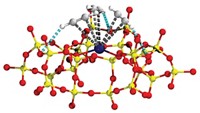Advertisement
Grab your lab coat. Let's get started
Welcome!
Welcome!
Create an account below to get 6 C&EN articles per month, receive newsletters and more - all free.
It seems this is your first time logging in online. Please enter the following information to continue.
As an ACS member you automatically get access to this site. All we need is few more details to create your reading experience.
Not you? Sign in with a different account.
Not you? Sign in with a different account.
ERROR 1
ERROR 1
ERROR 2
ERROR 2
ERROR 2
ERROR 2
ERROR 2
Password and Confirm password must match.
If you have an ACS member number, please enter it here so we can link this account to your membership. (optional)
ERROR 2
ACS values your privacy. By submitting your information, you are gaining access to C&EN and subscribing to our weekly newsletter. We use the information you provide to make your reading experience better, and we will never sell your data to third party members.
Synthesis
Natural Gas Gets An Upgrade
Fuels & Chemicals: Main-group metals selectively oxidize alkanes to make commodity alcohol esters
by Stephen K. Ritter
March 17, 2014
| A version of this story appeared in
Volume 92, Issue 11

The U.S. natural gas production boom is presenting a wealth of new research opportunities for chemists. The scientists have been getting creative in designing new methods for converting plentiful natural gas into fuels and chemicals that can better compete economically as alternatives to petroleum-derived products.
In one of these developments, a research team including Brian G. Hashiguchi and Roy A. Periana of Scripps Research Institute Florida and Daniel H. Ess of Brigham Young University has discovered that inexpensive main-group thallium and lead complexes work well at converting the typically unreactive alkanes in natural gas into alcohol esters (Science 2014, DOI: 10.1126/science.1249357). The new chemistry operates more selectively and at much lower temperatures than conventional natural gas reforming methods that operate at about 900 °C.
“This is a highly novel piece of work that opens the way to upgrading of natural gas to useful chemicals with simple materials and moderate conditions,” says Yale University chemistry professor Robert H. Crabtree, whose group studies catalytic C–H activation reactions.
Current commercial catalysts for oxidizing hydrocarbons such as propylene are based on solid metal oxides such as molybdenum oxide that can’t be used to process natural gas to make alcohols, Periana explains. These commercial catalysts cleave C–H bonds by reactions involving radicals and react more rapidly with the alcohol product than the starting alkane, generating undesired carbon dioxide.
In the new chemistry, soluble thallium(III) or lead(IV) salts in trifluoroacetic acid solvent operate stoichiometrically at only 180 °C, which in an optimized commercial catalytic process could lead to substantial energy savings. Using computational and experimental studies, the team found that thallium and lead trifluoroacetate complexes activate C–H bonds without radical formation to generate metal alkyl intermediates, which selectively leads to the alcohol trifluoroacetate esters.
Much of the new supply of shale gas has substantial amounts of ethane and propane mixed with methane, Periana notes. Unlike prior systems based on precious metals such as platinum and gold that reacted only with methane, thallium and lead work on all three alkanes, separately or as mixtures. A complete one-pot reaction can therefore controllably produce methanol, ethanol, propanol, ethylene glycol, isopropyl alcohol, and propylene glycol, he says.
Periana says the team is in discussions with several companies and entrepreneurs and would ideally like to jointly develop the technology with a petrochemical company or spin off a start-up company. “Initial targets would be higher-value, lower-volume commodity chemicals such as propylene glycol or isopropyl alcohol directly from propane,” Periana says. “The next targets after that could be to develop lower-temperature processes for higher-volume chemicals, such as converting methane to methanol and ethane to ethanol or ethylene as inexpensive sources of fuels and plastics.”



Join the conversation
Contact the reporter
Submit a Letter to the Editor for publication
Engage with us on Twitter